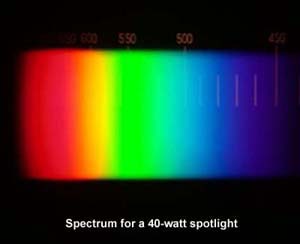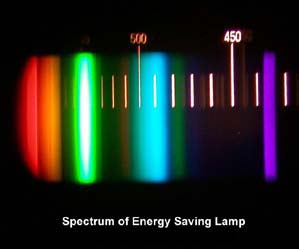Ultraviolet Light and the Visible Spectrum |
 It was Sir Isaac Newton who first investigated the colour content of white light. He passed a narrow beam of sunlight through a triangular prism and observed the spread of colours we associate with a rainbow. By selecting any one of the resulting colours and showing that, when it was passed through a prism, no further change occurred he showed that white light was a mixture of colours. We call the rainbow spread of colours a 'spectrum'. A spectrometer is a small telescope-like instrument containing a prism (or equivalent diffraction grating) that splits light into its constituent parts. Absence of a particular colour appears as a black line in the spectrum. Increase in the intensity of a particular colour appears as a heightening of the corresponding colour band. The picture top left was taken through a spectrometer and shows the spectrum produced from the light of a 40-watts spotlight. Above the spectrum, the corresponding wavelength in nanometres can just be seen as feint orange numbers.
The difference between the two spectra emphasises the importance of using a good light source when trying to reproduce faithfully the colours in a fossil or mineral specimen. Visible light is a miniscule part of a large, continuous spectrum of electromagnetic radiation. Beyond the violet end is ultraviolet radiation (Ultra=above), a constituent of sunlight, X-rays and gamma radiation. Beyond the red end of the visible spectrum is infrared radiation (Infra=below) sensed as heat, and radio waves. |
